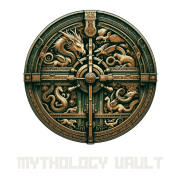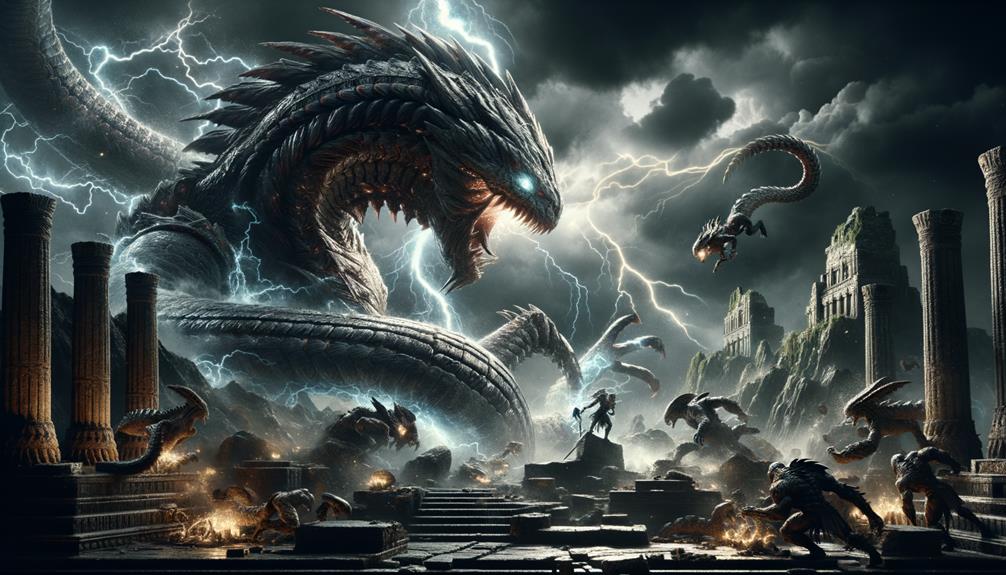In ancient Greek myth, chaos erupted when Typhon, the monstrous offspring of Gaia and Tartarus, challenged the gods' dominion. As the fearsome progenitor of nightmarish beasts like the Hydra and Cerberus, Typhon embodied primordial disorder. His rebellion culminated in an epic clash against Zeus, who hurled thunderbolts to defend Olympus' supremacy. Their battle personified the eternal struggle between rampant entropy and cosmic order. Zeus's victory over Typhon restored balance, imprisoning the chaotic titan beneath Mount Etna. This legendary narrative holds symbolic weight about the perpetual conflict we navigate—where disorder threatens, but harmony ultimately prevails. Discover more about this iconic tale's enduring cultural resonance.
Origins of Typhon
Typhon's origins trace back to the depths of Greek mythology, born from the wrath of Gaia, the earth goddess, and the abyss of Tartarus. His creation symbolized the primal chaos challenging divine order. A formidable figure, Typhon emerged from the union of Gaia and Tartarus as a direct consequence of Gaia's anger toward the Olympian gods, specifically Zeus, who had imprisoned the Titans, her earlier offspring.
Embodying the raw, untamed powers of the earth and underworld, Typhon's appearance was terrifying: a man's torso with a hundred snake heads, each breathing fire. His serpentine legs and countless wings adorned his colossal form, representing the ultimate rebellion against the gods' established order.
Zeus, the king of Olympians, became Typhon's direct adversary. Typhon's existence aimed to surpass Zeus, symbolizing the eternal struggle between chaos and order, the monstrous force seeking to upend the cosmos itself.
Typhon's Offspring
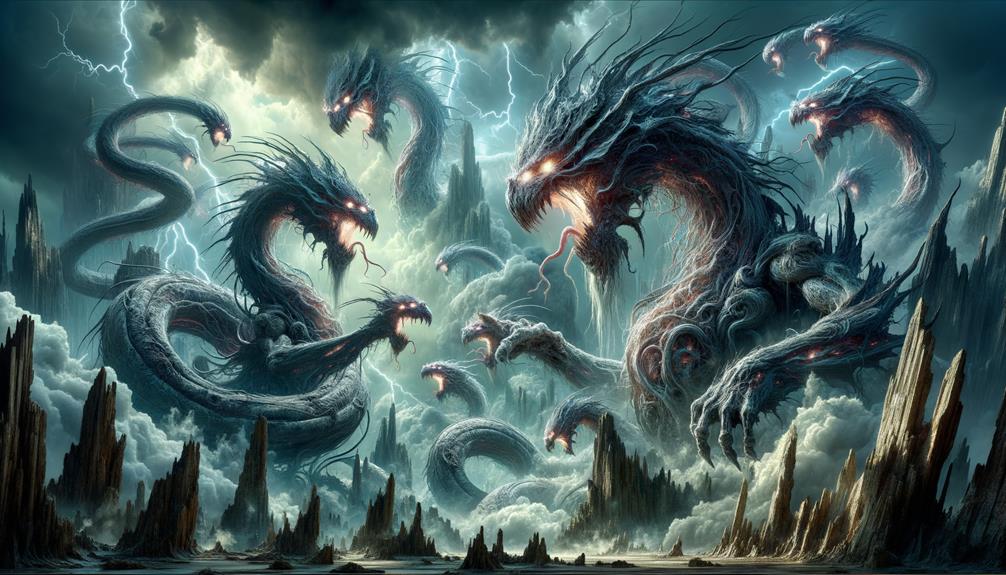
Typhon's monstrous spawn, born from his union with Echidna, unleashed a new generation of formidable creatures that challenged heroes and threatened the gods. These offspring embodied raw power and primal fear, becoming trials heroes overcame, reflecting the eternal clash between order and chaos.
The Hydra, regrowing its severed heads, symbolized the relentless obstacles Hercules faced. Cerberus, the three-headed hound guarding the Underworld, represented the boundary between life and death, an intimidating sentinel none could bypass easily. The Chimera, a lioness with a goat's head and serpent's tail, stood as a hybrid threat, a fusion of dangers heroes like Bellerophon conquered.
| Offspring | Description | Hero Conqueror |
|---|---|---|
| Hydra | Water serpent with regenerating heads | Hercules |
| Cerberus | Three-headed hound guarding the Underworld | Hercules |
| Chimera | Fire-breathing lioness with goat head and serpent tail | Bellerophon |
| Nemean Lion | Massive beast with impenetrable skin | Hercules |
The Sphinx tested human wisdom with riddles, while the Nemean Lion's invulnerable hide posed a challenge of raw might and cunning. Typhon's offspring, fearsome in their own right, shaped the legends of ancient heroes, reinforcing timeless archetypes in the hero's journey.
Zeus Vs. Typhon
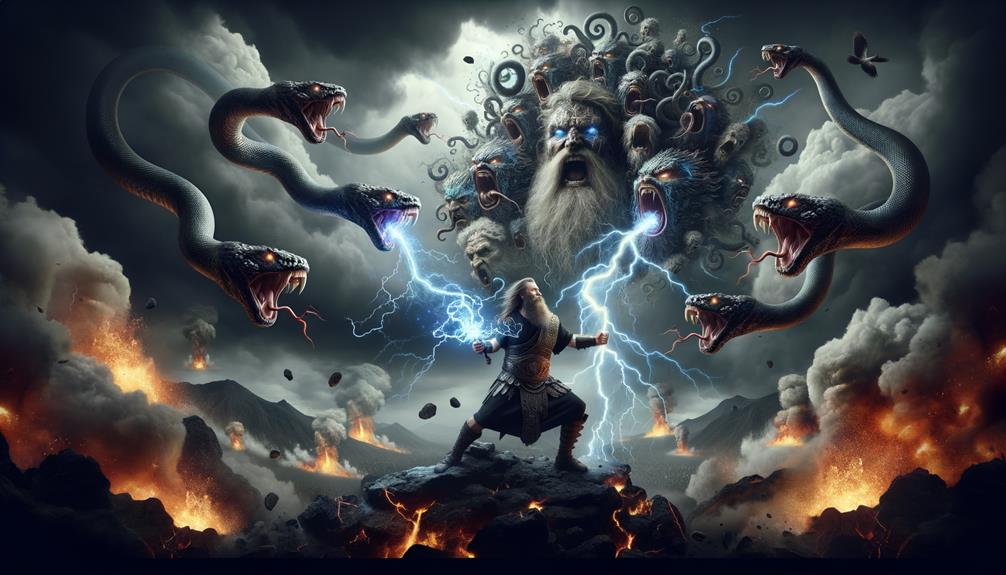
Zeus, hurling lightning from his hands, confronted Typhon in a battle that would decide the fate of Olympus and the entire cosmos. This clash wasn't just between titans – it symbolized the conflict between order and chaos itself. Typhon, known as the Father of All Monsters, sought to overthrow the Greek Gods and plunge the world into mayhem.
As ruler of Olympus, Zeus couldn't tolerate such a threat. He stood resolute, upholding the principles of justice and stability that the gods embodied. Typhon's ferocious power was unmatched, but Zeus's determination never faltered. Each lightning bolt Zeus unleashed asserted his sovereignty, repelling the chaos Typhon represented.
The battle raged relentlessly, shaking earth and heavens alike. Zeus's strikes demonstrated his supreme authority and divine might. Ultimately, Zeus defeated Typhon, securing the Olympian gods' reign and restoring cosmic balance. This victory reaffirmed order's triumph over chaos – a recurring Greek mythological theme.
Typhon's Defeat
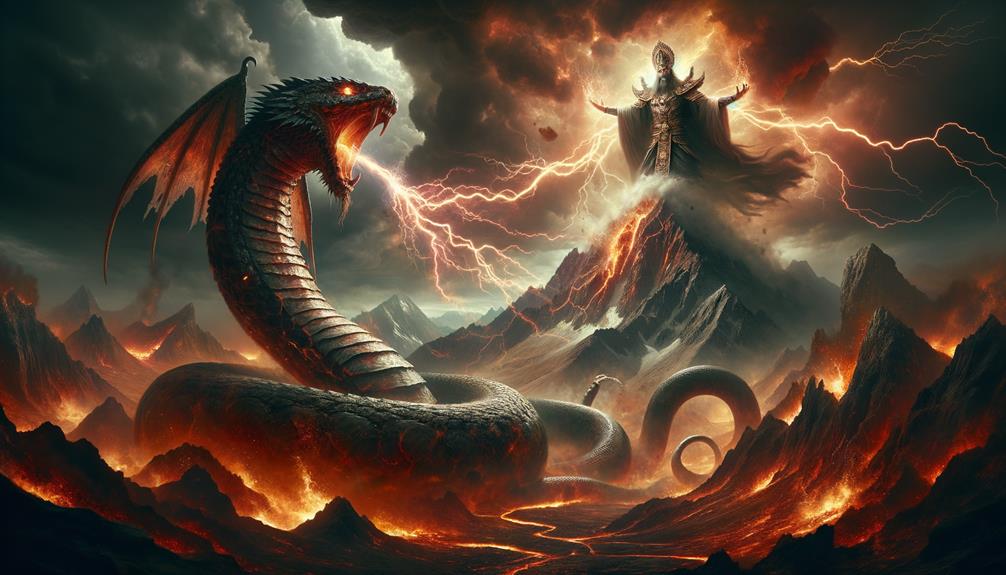
The clash between Zeus and the monstrous Typhon marked a seismic shift in the cosmic order. Zeus, armed with thunderbolts, faced Typhon – the embodiment of chaos itself. As lightning streaked across the skies, Zeus unleashed volley after volley, each strike echoing his unwavering resolve to uphold divine supremacy.
Athena and Dionysus stood alongside Zeus, their bravery exemplifying the gods' unity. Unflinching, they confronted Typhon, risking everything to maintain the celestial equilibrium. Their combined onslaught pushed the beast to the precipice, but it was Zeus who sealed Typhon's fate with a cataclysmic blow.
Vanquished, Typhon was cast into the abyss of Tartarus by Zeus, doomed to eternal imprisonment beneath Mount Etna's smoldering peak. This victory transcended a mere battle – it signaled the triumph of order over entropy, solidifying the gods' undisputed reign and etching a seminal chapter in Greek myth.
Typhon in Art
In the creative realm, Typhon emerges as a vivid representation of chaos and rebellion, his serpentine limbs and multiple heads striking fear into the hearts of gods and mortals. Artists depict his monstrous form in Greek art, symbolizing raw, untamed nature challenging the Greek pantheon's imposed order. Typhon's menacing presence, with multiple snake heads and coiled legs, evokes overwhelming power and disorder.
Every Typhon depiction highlights his immense size and fiery breath, capturing his battles with the gods, especially his epic clashes with Zeus. These scenes symbolize the eternal struggle between order and chaos, creation and destruction. His imprisonment under Mount Etna represents his defeat and subjugation, with volcanic eruptions conveying his lingering threat, as if his wrath still simmers beneath, ready to break free.
Through these artistic renderings, Typhon's story transcends mere myth, becoming a powerful narrative of rebellion against cosmic order's inevitable triumph over chaos.
Legacy in Mythology
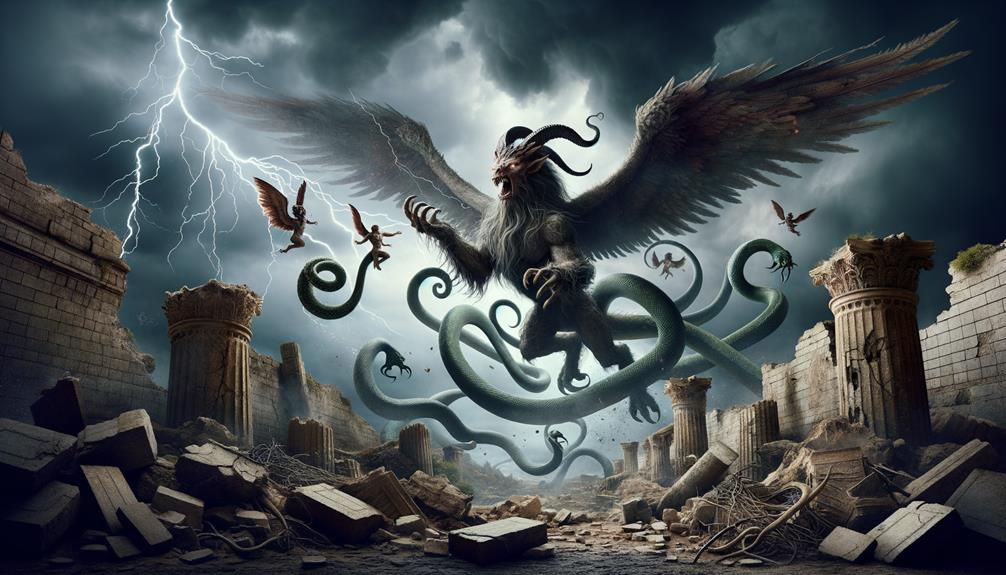
As I delve into Typhon's mythology, his monstrous offspring and eternal clash with Zeus symbolize the timeless battle between chaos and order. This primal conflict reverberates through ancient tales of heroism and modern storytelling, shaping our understanding of the world's elemental forces. Typhon's enduring influence transcends eras, reminding us that these mythic struggles mirror our experiences.
Typhon's Mythical Origins
Typhon's primal origins trace back to the union of Gaea, the Earth Goddess, and Tartarus, the Primordial Abyss, representing the raw, chaotic forces of nature. His fire-breathing, monstrous form with impenetrable skin embodied indomitable destruction. As the Father of All Monsters, Typhon spawned fearsome offspring like the Hydra, Chimera, and Cerberus, presenting legendary trials for heroes like Heracles during his Twelve Labors.
Typhon's clash with Zeus wasn't just a battle of titans but a pivotal moment symbolizing order triumphing over chaos. Zeus trapped Typhon beneath Mount Etna, solidifying the King of Gods' supremacy over the Olympians. Even imprisoned, Typhon's legacy as a powerful, awe-inspiring deity endures.
| Aspect | Detail | Significance |
|---|---|---|
| Parentage | Born from Gaea and Tartarus | Represents primal, chaotic forces |
| Physical Form | Fire-breathing monster with impenetrable skin | Embodies indomitable destruction |
| Offspring | Hydra, Chimera, Cerberus | Source of legendary challenges |
| Imprisonment | Trapped beneath Mount Etna by Zeus | Order overcoming chaos |
Symbolism and Significance
Typhon's defeat at Zeus's hands symbolizes more than a mythological tale – it represents the eternal clash between order and chaos echoing through time. In Greek legend, Zeus personifies order, law, and cosmic equilibrium, while Typhon embodies untamed, destructive turmoil. Their epic battle transcends a conflict of titans, serving as a narrative on maintaining universal harmony.
Typhon's legacy as the progenitor of infamous monsters like Cerberus and the Hydra amplifies his role as chaos personified in Greek myth. Each monstrous offspring manifests chaos's formidable, destructive nature, illustrating the enduring threats order, embodied by Zeus, must continually overcome to preserve balance.
Typhon's imprisonment under Mount Etna warns against defying divine authority. Chaos, however powerful, can be contained but never eradicated. This symbolism reflects the perpetual order versus chaos struggle ingrained in mythological narratives. Ultimately, Typhon's defeat and subsequent legacy highlight the eternal dance between chaos and order, a dance defining the very essence of myth and reality.
Influence on Culture
The epic clash between Zeus and Typhon didn't merely signify victory; it symbolized an eternal battle between order and chaos. Ancient Greek myths around Typhon's monstrous offspring, like the Lernaean Hydra, embodied this relentless presence of chaos.
Imprisoning Typhon under Mount Etna warned against defying divine authority. These tales resonated deeply, revealing the consequences of challenging the gods. Typhon's legacy, steeped in fear and awe, transcended generations, embedding itself in the cultural psyche.
Greek mythology's richness forever bore the mark of these stories. The struggle between Zeus and Typhon became a cornerstone, exemplifying the hero's journey and the archetypal conflict of good versus evil. These myths evolved, finding new life in modern storytelling, underscoring their timeless relevance.
Typhon's battles with the Olympians weren't just tales; they were symbolic narratives shaping cultural understanding of chaos versus order, leaving an enduring imprint on mythology and beyond.
Frequently Asked Questions
Who Is Typhon Father of All Monsters?
Who can withstand the monstrous might of Typhon? Born of primordial deities Gaea and Tartarus, I am the father of fearsome beasts whose terror casts a shadow over gods and mortals alike. My progeny, raw and untamed, stand as living proof of primal power incarnate.
What Monsters Did Typhon Create?
Typhon spawned chaotic beasts: the multi-headed, ever-regenerating Hydra; the Chimera, a monstrous hybrid breathing fire; Cerberus, the three-headed hound guarding the Underworld; the Sphinx, posing enigmatic riddles; and the invulnerable Nemean Lion, a relentless scourge.
Who Did Typhon Fight?
Zeus, Athena, Dionysus, and I battled the embodiment of chaos itself – Typhon. Our confrontation symbolized the age-old clash between order and mayhem. In the end, we emerged victorious, imprisoning Typhon beneath Mount Etna's fiery depths, solidifying harmony's triumph over turmoil.
Who Was the Father of All Monsters in Greek Mythology?
Typhon's legend casts him as the father of monsters, birthing horrors like the Hydra and Chimera. Conceived by primordial deities Gaea and Tartarus, he embodied chaos, challenging Olympian gods. His offspring shaped enduring mythological tales.
